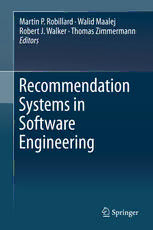Table Of ContentMartin P. Robillard · Walid Maalej
Robert J. Walker · Thomas Zimmermann
Editors
Recommendation
Systems in
Software
Engineering
Recommendation Systems in Software Engineering
Martin P. Robillard • Walid Maalej (cid:129)
Robert J. Walker (cid:129) Thomas Zimmermann
Editors
Recommendation
Systems in
Software
Engineering
123
Editors
MartinP.Robillard WalidMaalej
McGillUniversity UniversityofHamburg
Montréal,QC Hamburg
Canada Germany
RobertJ.Walker ThomasZimmermann
UniversityofCalgary MicrosoftResearch
Calgary,AB Redmond,WA
Canada USA
ISBN978-3-642-45134-8 ISBN978-3-642-45135-5(eBook)
DOI10.1007/978-3-642-45135-5
SpringerHeidelbergNewYorkDordrechtLondon
LibraryofCongressControlNumber:2014931203
©Springer-VerlagBerlinHeidelberg2014
Thisworkissubjecttocopyright.AllrightsarereservedbythePublisher,whetherthewholeorpartof
thematerialisconcerned,specificallytherightsoftranslation,reprinting,reuseofillustrations,recitation,
broadcasting,reproductiononmicrofilmsorinanyotherphysicalway,andtransmissionorinformation
storageandretrieval,electronicadaptation,computersoftware,orbysimilarordissimilarmethodology
nowknownorhereafterdeveloped.Exemptedfromthislegalreservationarebriefexcerptsinconnection
with reviews or scholarly analysis or material supplied specifically for the purpose of being entered
and executed on a computer system, for exclusive use by the purchaser of the work. Duplication of
this publication or parts thereof is permitted only under the provisions of the Copyright Law of the
Publisher’slocation,initscurrentversion,andpermissionforusemustalwaysbeobtainedfromSpringer.
PermissionsforusemaybeobtainedthroughRightsLinkattheCopyrightClearanceCenter.Violations
areliabletoprosecutionundertherespectiveCopyrightLaw.
Theuseofgeneraldescriptivenames,registerednames,trademarks,servicemarks,etc.inthispublication
doesnotimply,evenintheabsenceofaspecificstatement,thatsuchnamesareexemptfromtherelevant
protectivelawsandregulationsandthereforefreeforgeneraluse.
While the advice and information in this book are believed to be true and accurate at the date of
publication,neithertheauthorsnortheeditorsnorthepublishercanacceptanylegalresponsibilityfor
anyerrorsoromissionsthatmaybemade.Thepublishermakesnowarranty,expressorimplied,with
respecttothematerialcontainedherein.
Printedonacid-freepaper
SpringerispartofSpringerScience+BusinessMedia(www.springer.com)
Preface
Software developershave always used tools to performtheir work. In the earliest
daysofthediscipline,thetoolsprovidedbasiccompilationandassemblyfunction-
ality. Then came tools and environments that increasingly provided sophisticated
dataaboutthesoftwareunderdevelopment.Aroundtheturnofthemillennium,the
systematic and large-scale accumulation of software engineering data opened up
new opportunities for the creation of tools that infer information estimated to be
helpful to developers in a given context. This new type of software development
tools came to be known as recommendation systems, in parallel with similar
developmentsinotherdomainssuchasthee-commerce.
Recommendationsystemsinsoftwareengineering(RSSEs)sharecommonalities
with conventional recommendation systems: mainly in their usage model, the
usual reliance on data mining, and in the predictive nature of their functionality.
Beyond these superficial traits, recommendation systems in software engineering
are generally different from those in other domains. Traditional recommendation
systems are heavily user centric. Users generally create the data items directly,
e.g.,intheformofratings.Animportantchallengefortraditionalrecommendation
systems is to infer and model evolving user preferences and needs. In contrast,
the major challenge for designing RSSEs is to automatically interpret the highly
technicaldatastoredinsoftwarerepositories.
Realizing that some of the important knowledge that is necessary to build
recommendation systems in a technical domain would not be readily found in
existing books and other resources on conventionalrecommendationsystems, we
setabouttocaptureasmuchofthisknowledgeaspossibleinthisbook.
AboutThisBook
This book has been a community effort. Prospective authors submitted chapter
proposals to an open call for contributions. The proposals and later the selected
chapters were reviewed by the editors over four review iterations. In addition,
v
vi Preface
the authors participating in this book were asked to review chapters by other
contributors.
A unique aspect of this book was the RSSE Hamburg Meeting in April 2013.
The contributing authors were invited to this 2-day event to present their chapter
ideas, discuss the RSSE state of the art, andparticipate in editingand networking
sessions. The meeting greatly helped to unify the presentation and content of this
book and to further consolidate the RSSE community effort. The meeting has
been part of a series of events that started with a workshop on software analysis
for recommendation systems at McGill University’s Bellairs Research Station in
Barbados in 2008 and follow-up workshops at the ACM SIGSOFT International
Symposium on the Foundations of Software Engineering in 2008 and at the
ACM/IEEE InternationalConferenceon Software Engineeringin 2010 and 2012.
Thelastworkshopin2012hadover70participants,whichshowsalargeinterestin
thetopic.
Structure andContent
This book collects, structures, and formalizes knowledge on recommendation
systems in software engineering. It adopts a pragmatic approach with an explicit
focus on system design, implementation, and evaluation. The book is intended to
complementexisting texts on recommender systems, which cover algorithms and
traditionalapplicationdomains.
Thebookconsistsofthreeparts:
PartI:Techniques This part introduces basic techniques for building recom-
menders in software engineering, including techniques not only to collect and
processsoftwareengineeringdatabutalsotopresentrecommendationstousers
aspartoftheirworkflow.
PartII:Evaluation This part summarizes methods and experimental designs to
evaluaterecommendationsinsoftwareengineering.
PartIII:Applications This part describes needs, issues, and solution concepts
involved in entire recommendation systems for specific software engineering
tasks, focusing on the engineering insights required to make effective recom-
mendations.
TargetAudience
The book contains knowledge relevant to software professionals and to computer
science or software engineering students with an interest in the application of
recommendationtechnologiestohighlytechnicaldomains,including:
Preface vii
(cid:129) seniorundergraduateandgraduatestude ntsworkingonrecommendationsystems
ortakingacourseinsoftwareengineeringorapplieddatamining;
(cid:129) researchers working on recommendation systems or on software engineering
tools;
(cid:129) softwareengineeringpractitionersdevelopingrecommendationsystemsorsimi-
larapplicationswithpredictivefunctionality;and
(cid:129) instructorsteachingacourseonreco mmendationsystems,applieddatamining,
orsoftwareengineering.Thebookwillbeparticularlysuitedtograduatecourses
involvingaprojectcomponent.
Website andResources
This bookhas a webpageat rsse.org/book,which is part of the RSSE community
portal rsse.org. This webpage contains free supplemental materials for readers of
thisbookandanyoneinterestedinrecommendationsystemsin softwareengineer-
ing,including:
(cid:129) lectureslides,datasets,andsourcecode;
(cid:129) anarchiveofpreviousRSSEworkshopsandmeetings;
(cid:129) acollectionofpeople,papers,groups,andtoolsrelatedtoRSSE.Pleasecontact
anyoftheeditorsifyouwouldliketobeaddedortosuggestadditionalresources.
InadditiontotheRSSEcommunity,thereareseveralotherstartingpoints.
(cid:129) The article “Recommendation Systems for Software Engineering,” IEEE Soft-
ware,27(4):80–86,July–August2010,providesashortintroductiontothetopic.
(cid:129) The latest research on RSSE systems is regularly published and presented at
the International Conference on Software Engineering (ICSE), International
Symposium on the Foundations of Software Engineering (FSE), International
ConferenceonAutomatedSoftwareEngineering(ASE),WorkingConferenceon
MiningSoftwareRepositories(MSR),andInternationalConferenceonSoftware
Maintenance(ICSM).
(cid:129) ManyresearchersworkingonRSSEsystemsmeetattheInternationalWorkshop
onRecommendationSystemsforSoftwareEngineering,whichistypicallyheld
everyotheryear.
(cid:129) TheACMConferenceonRecommenderSystems(RecSys)coversrecommender
researchingeneralandinmanydifferentapplicationdomains,notjustsoftware
engineering.
(cid:129) Severalbooksonbuildingconventionalrecommendationsystemshavebeenwrit-
ten. To get started, we recommend “Recommender Systems: An Introduction”
(2010)byJannach,Zanker,Felfernig,andFriedrich.
viii Preface
Acknowledgments
Weareindebtedtothemanypeoplewhohavemadethisbookpossiblethroughtheir
diversecontributions.Inparticular,wethank:
(cid:129) Theauthorsofthechaptersinthisbookforthegreatworkthattheyhavedonein
writingabouttopicsrelatedtoRSSEsandtheirtimelyandconstructivereviews
ofotherchapters.
(cid:129) The Springerstaff, inparticularRalf Gerstner,fortheirdedicationandhelpful-
nessthroughouttheproject.
(cid:129) The Dean of the MIN faculty and Head of Informatics Department at the
Universityof Hamburg,fortheir financialand logisticalsupportforthe editing
workshop,and RebeccaTiarksand TobiasRoehm, fortheir helpwith the local
organizationoftheworkshop.
(cid:129) TheattendeesatthepastRSSEworkshops,fortheirenthusiasmaboutthetopic
andtheirinfluxofideas.
(cid:129) TheMcGillBellairsResearchInstitute,forprovidinganidealvenueforaninitial
workshoponthetopic.
Montréal,QC,Canada MartinP.Robillard
Hamburg,Germany WalidMaalej
Calgary,AB,Canada RobertJ.Walker
Redmond,WA,USA ThomasZimmermann
October2013
Contents
1 AnIntroductiontoRecommendationSystemsinSoftware
Engineering ................................................................. 1
MartinP.RobillardandRobertJ.Walker
PartI Techniques
2 BasicApproachesinRecommendationSystems ........................ 15
Alexander Felfernig, Michael Jeran, Gerald Ninaus,
FlorianReinfrank,StefanReiterer,andMartinStettinger
3 DataMining................................................................. 39
TimMenzies
4 RecommendationSystemsin-the-Small.................................. 77
LauraInozemtseva,ReidHolmes,andRobertJ.Walker
5 SourceCode-BasedRecommendationSystems ......................... 93
KimMensandAngelaLozano
6 MiningBugData ........................................................... 131
KimHerzigandAndreasZeller
7 Collecting and Processing Interaction Data
forRecommendationSystems............................................. 173
WalidMaalej,ThomasFritz,andRomainRobbes
8 DeveloperProfilesforRecommendationSystems....................... 199
AnnieT.T.YingandMartinP.Robillard
9 RecommendationDelivery................................................. 223
EmersonMurphy-HillandGailC.Murphy
ix

